Robust Handover Optimization Technique with Fuzzy Logic Controller for Beyond 5G Mobile Networks †
Abstract
:1. Introduction
- Proposition of a Robust Handover Optimization Technique with Fuzzy Logic Controller (RHOT-FLC) to automatically adjust the HCPs more efficiently for 5G and B5G mobile networks. In other words, we developed a fuzzy-based algorithm that utilizes the advantages of the FL system to automatically adjust the TTT and HOM simultaneously. The proposed technique exploits the UE’s information such as RSRP, RSRQ, and speed to adapt the TTT and HOM as the system outputs.
- Evaluation of system performance in terms of HO probability (HOP), HO failure (HOF), HO ping-pong (HOPP) effect, HO latency (HOL), and HO interruption time (HIT), with different mobility speed scenarios. The RHOT-FLC technique aims to improve the HO performance in a B5G mobile system in terms of these mentioned KPIs.
2. Related Work
3. Proposed System
3.1. Overview
3.2. Robust Handover Optimization Technique with Fuzzy Logic Controller (RHOT-FLC)
- The RSRP for all gNBs is sorted and compared to the gNBs target station. If the Equation (2) condition is not fulfilled, the HO decision is not performed. Else,
- 2.
- Update the system inputs with RSRP, RSRQ, and UE speed.
- 3.
- Convert the inputs values into fuzzy sets and calculate the degree of each membership function, according to Equation (1) (Figure 2).
- 4.
- Apply the proposed rules (48 if/then rules) for each membership.
- 5.
- The TTT and HOM are updated as system output according to the three input parameters conditions. The input parameters are defined in 48 cases.
- 6.
- Update the system with adapted HCPs to perform the HO decision.
| Algorithm 1: RHOT-FLC |
|
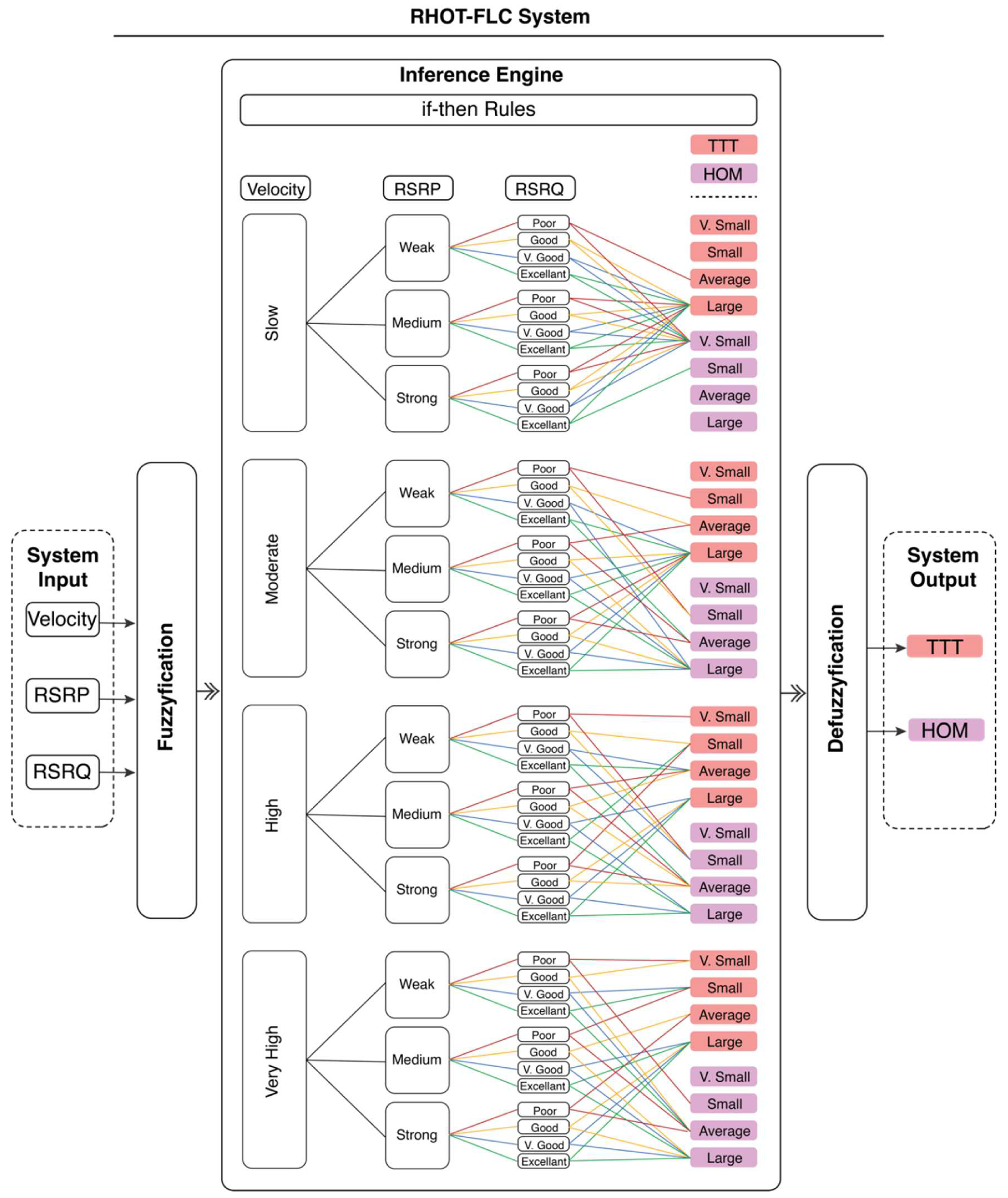
4. System and Simulation Model and Performance Metrics
4.1. Network Deployment Scenario
4.2. Simulation Parameters
4.3. Performance Metrics
4.3.1. Handover Probability (HOP)
4.3.2. Handover Failure (HOF)
4.3.3. Handover Ping-Pong (HOPP)
4.3.4. Handover Latency (HOL)
4.3.5. Handover Interruption Time (HIT)
5. Results and Discussions
5.1. Handover Probability (HOP)
5.2. Handover Failure (HOF)
5.3. Handover Ping Pong (HOPP)
5.4. Handover Latency (HOL)
5.5. Handover Interruption Time (HIT)
6. Conclusions
Author Contributions
Funding
Institutional Review Board Statement
Informed Consent Statement
Data Availability Statement
Conflicts of Interest
Abbreviations
| Acronym | Definition |
| 5G | Fifth Generation |
| 4G | Fourth Generation |
| LTE | Long-Term Evolution |
| 3GPP | Third-Generation Partnership Project |
| UE | User Equipment |
| B5G | Beyond Fifth Generation |
| RHOT-FLC | Robust Handover Optimization Technique with Fuzzy Logic Controller |
| HO | Handover |
| HCP | Handover Control Parameter |
| HOM | Handover Margin |
| TTT | Time-To-Trigger |
| PRB | Physical Resource Block |
| RSRP | Reference Signal Received Power |
| RSRQ | Reference Signal Received Quality |
| SNR | Signal-to-Noise Ratio |
| SINR | Signal to Interference & Noise Ratio |
| RSSI | Received Signal Strength Indicator |
| HOPP | Handover Ping-Pong |
| HOP | Handover Probability |
| HOF | Handover Failure |
| HOL | Handover Latency |
| HIT | Handover Interruption Time |
| MRO | Mobile Robustness Optimization |
| BS | Base Station |
| FLC | Fuzzy Logic Controller |
| RLF | Radio Link Failure |
| eNB | eNodeB (LTE) |
| gNB | gNodeB (5G) |
| MADM | Multi-Attribute Decision-Making |
| SAW | Simple Additive Weighting |
| QoS | Quality of Service |
| RSS | Received Signal Strength |
| AHP | Analytic Hierarchy Process |
| TOPSIS | Technique for Order of Preference by Similarity to Ideal Solution |
| HetNet | Heterogeneous Network |
| ATO | Auto Tuning Optimization |
| PSO | Particle Swarm Optimization |
| MLB | Mobility Load Balance |
| KPIs | Key Performance Indicators |
| SON | Self-Organization Network |
| WFSO | Weighted Fuzzy Self-Optimization |
| UHDV | Ultra-High-Definition Video |
References
- Alraih, S.; Shayea, I.; Behjati, M.; Nordin, R.; Abdullah, N.F.; Abu-Samah, A.; Nandi, D. Revolution or Evolution? Technical Requirements and Considerations towards 6G Mobile Communications. Sensors 2022, 22, 762. [Google Scholar] [CrossRef] [PubMed]
- Kasim, A.N. A Survey Mobility Management in 5G Networks. arXiv 2020, arXiv:2006.15598. [Google Scholar]
- Shayea, I.; Ergen, M.; Azmi, M.H.; Çolak, S.A.; Nordin, R.; Daradkeh, Y.I. Key challenges, drivers and solutions for mobility management in 5g networks: A survey. IEEE Access 2020, 8, 172534–172552. [Google Scholar] [CrossRef]
- Nguyen, M.-T.; Kwon, S. Machine Learning–Based Mobility Robustness Optimization Under Dynamic Cellular Networks. IEEE Access 2021, 9, 77830–77844. [Google Scholar] [CrossRef]
- Lee, C.; Cho, H.; Song, S.; Chung, J.-M. Prediction-based conditional handover for 5G mm-Wave networks: A deep-learning approach. IEEE Veh. Technol. Mag. 2020, 15, 54–62. [Google Scholar] [CrossRef]
- Wang, Z.; Li, L.; Xu, Y.; Tian, H.; Cui, S. Handover control in wireless systems via asynchronous multiuser deep reinforcement learning. IEEE Internet Things J. 2018, 5, 4296–4307. [Google Scholar] [CrossRef]
- Shayea, I.; Ismail, M.; Nordin, R.; Ergen, M.; Ahmad, N.; Abdullah, N.F.; Alhammadi, A.; Mohamad, H. New weight function for adapting handover margin level over contiguous carrier aggregation deployment scenarios in LTE-advanced system. Wirel. Pers. Commun. 2019, 108, 1179–1199. [Google Scholar] [CrossRef]
- Souza, D.D.S.; Vieira, R.F.; Seruffo, M.C.D.R.; Cardoso, D.L. A novel heuristic for handover priority in mobile heterogeneous networks. IEEE Access 2019, 8, 4043–4050. [Google Scholar] [CrossRef]
- Ait Mansour, A.; Enneya, N.; Ouadou, M. A velocity-aware handover trigger in two-tier heterogeneous networks. Future Internet 2018, 10, 9. [Google Scholar] [CrossRef]
- Bilen, T.; Canberk, B.; Chowdhury, K.R. Handover management in software-defined ultra-dense 5G networks. IEEE Netw. 2017, 31, 49–55. [Google Scholar] [CrossRef]
- Sun, Y.; Chang, Y.; Hu, M.; Zeng, T. A universal predictive mobility management scheme for urban ultra-dense networks with control/data plane separation. IEEE Access 2017, 5, 6015–6026. [Google Scholar] [CrossRef]
- Vondra, M.; Becvar, Z. Distance-based neighborhood scanning for handover purposes in network with small cells. IEEE Trans. Veh. Technol. 2015, 65, 883–895. [Google Scholar] [CrossRef]
- Alraih, S.; Nordin, R.; Shayea, I.; Abdullah, N.F.; Alhammadi, A. Ping-Pong Handover Effect Reduction in 5G and Beyond Networks. In Proceedings of the 2021 IEEE Microwave Theory and Techniques in Wireless Communications (MTTW), Riga, Latvia, 7–8 October 2021; pp. 97–101. [Google Scholar]
- Muñoz, P.; Barco, R.; de la Bandera, I. On the potential of handover parameter optimization for self-organizing networks. IEEE Trans. Veh. Technol. 2013, 62, 1895–1905. [Google Scholar] [CrossRef]
- Silva, K.D.C.; Becvar, Z.; Frances, C.R.L. Adaptive hysteresis margin based on fuzzy logic for handover in mobile networks with dense small cells. IEEE Access 2018, 6, 17178–17189. [Google Scholar] [CrossRef]
- Nguyen, M.T.; Kwon, S.; Kim, H. Mobility robustness optimization for handover failure reduction in LTE small-cell networks. IEEE Trans. Veh. Technol. 2017, 67, 4672–4676. [Google Scholar] [CrossRef]
- NS3, LENA. LTE-EPC Network Simulator (LENA). Available online: https://www.nsnam.org/ (accessed on 1 February 2015).
- Hegazy, R.D.; Nasr, O.A.; Kamal, H.A. Optimization of user behavior based handover using fuzzy Q-learning for LTE networks. Wirel. Netw. 2018, 24, 481–495. [Google Scholar] [CrossRef]
- Piro, G.; Grieco, L.A.; Boggia, G.; Capozzi, F.; Camarda, P. Simulating LTE cellular systems: An open-source framework. IEEE Trans. Veh. Technol. 2010, 60, 498–513. [Google Scholar] [CrossRef]
- Liu, Q.; Kwong, C.F.; Zhang, S.; Li, L. Fuzzy-TOPSIS based optimal handover decision-making algorithm for fifth-generation of mobile communications system. J. Commun. 2019, 14, 945–950. [Google Scholar] [CrossRef]
- Goyal, R.; Goyal, T.; Kaushal, S.; Kumar, H. Fuzzy AHP Based Technique for Handover Optimization in Heterogeneous Network. In Proceedings of 2nd International Conference on Communication, Computing and Networking; Springer: Singapore, 2019; pp. 293–301. [Google Scholar]
- Alhammadi, A.; Roslee, M.; Alias, M.Y.; Shayea, I.; Alriah, S.; Abas, A.B. Advanced handover self-optimization approach for 4G/5G HetNets using weighted fuzzy logic control. In Proceedings of the 2019 15th International Conference on Telecommunications (ConTEL), Graz, Austria, 3–5 July 2019; pp. 1–6. [Google Scholar]
- 3GPP. TS 36.839, Evolved Universal Terrestrial Radio Access (E-UTRA); Mobility Enhancements in Heterogeneous Networks; (Release 11). Available online: https://portal.3gpp.org/desktopmodules/Specifications/SpecificationDetails.aspx?specificationId=2540 (accessed on 1 January 2019).
- Lema, G.G. Handover Performance Evaluation Under Dynamic User Characteristics. Wirel. Pers. Commun. 2021, 120, 2991–3004. [Google Scholar] [CrossRef]
- Gharbia, M.B.; Bouallegue, R. Handover Decision Algorithm in Femtocell Long Term Evolution Networks. In Proceedings of the 2018 Seventh International Conference on Communications and Networking (ComNet), Hammamet, Tunisia, 1–3 November 2018; pp. 1–6. [Google Scholar]
- Yao, D.; Su, X.; Liu, B.; Zeng, J. A mobile handover mechanism based on fuzzy logic and MPTCP protocol under SDN architecture. In Proceedings of the 2018 18th International Symposium on Communications and Information Technologies (ISCIT), Bangkok, Thailand, 26–29 September 2018; pp. 141–146. [Google Scholar]
- Saeed, M.; El-Ghoneimy, M.; Kamal, H. An enhanced fuzzy logic optimization technique based on user mobility for LTE handover. In Proceedings of the 2017 34th National Radio Science Conference (NRSC), Alexandria, Egypt, 13–16 March 2017; pp. 230–237. [Google Scholar]
- Silva, K.C.; Becvar, Z.; Cardoso, E.H.; Francês, C.R. Self-tuning handover algorithm based on fuzzy logic in mobile networks with dense small cells. In Proceedings of the 2018 IEEE Wireless Communications and Networking Conference (WCNC), Barcelona, Spain, 15–18 April 2018; pp. 1–6. [Google Scholar]
- Chen, Y.-S.; Chang, Y.-J.; Tsai, M.-J.; Sheu, J.-P. Fuzzy-Logic-Based Handover Algorithm for 5G Networks. In Proceedings of the 2021 IEEE Wireless Communications and Networking Conference (WCNC), Nanjing, China, 29 March–1 April 2021; pp. 1–7. [Google Scholar]
- Cicioğlu, M. Fuzzy Logic based Handover Management in Small Cell Networks. In Proceedings of the 2021 29th Signal Processing and Communications Applications Conference (SIU), Istanbul, Turkey, 9–11 June 2021; pp. 1–4. [Google Scholar]
- El Banna, R.; ELAttar, H.M.; Abou El-Dahab, M.M. Fast Adaptive Handover using Fuzzy Logic for 5G Communications on High Speed Trains. In Proceedings of the 2021 16th International Conference on Telecommunications (ConTEL), Zagreb, Croatia, 30 June–2 July 2021; pp. 10–17. [Google Scholar]
- 3GPP. TS 36.133, Evolved Universal Terrestrial Radio Access (E-UTRA); Requirements for Support of Radio Resource Management; (Release 16). Available online: https://portal.3gpp.org/desktopmodules/Specifications/SpecificationDetails.aspx?specificationId=2420 (accessed on 1 October 2021).
- NOVELSAT. Building the Future of 5G Video. Available online: https://novelsat.com/wp-content/uploads/2021/09/NOVELSAT-Whitepaper-Building-the-Future-of-5G-Video-1.pdf (accessed on 13 November 2021).
- Stack, T.N. The Impact Video Data Traffic Has on Net Neutrality. Available online: https://thenewstack.io/video-will-increasingly-crowd-data/ (accessed on 8 January 2022).
- 3GPP. Release 16. Available online: https://www.3gpp.org/release-16 (accessed on 3 October 2021).
- IWPC. T.I.W.I.C. 5G Millimeter Wave Frequencies and Mobile Networks; (Whitepaper). 2019. Available online: https://www.skyworksinc.com/-/media/SkyWorks/Documents/Articles/IWPC_062019.pdf (accessed on 20 December 2021).
- Huo, Y.; Dong, X.; Xu, W. 5G cellular user equipment: From theory to practical hardware design. IEEE Access 2017, 5, 13992–14010. [Google Scholar] [CrossRef]
- 3GPP. TR 38.901, Study on Channel Model for Frequencies from 0.5 to 100 GHz; (Release 16). Available online: https://portal.3gpp.org/desktopmodules/Specifications/SpecificationDetails.aspx?specificationId=3173 (accessed on 16 November 2021).
- 3GPP. TR 36.881, Study on Latency Reduction Techniques for LTE; (Release 14). Available online: https://portal.3gpp.org/desktopmodules/Specifications/SpecificationDetails.aspx?specificationId=2901 (accessed on 22 October 2021).
- Ericsson. Reducing Mobility Interruption Time in 5G Networks. Available online: https://www.ericsson.com/en/blog/2020/4/reducing-mobility-interruption-time-5g-networks (accessed on 8 October 2021).
- Park, H.-S.; Lee, Y.; Kim, T.-J.; Kim, B.-C.; Lee, J.-Y. Handover mechanism in NR for ultra-reliable low-latency communications. IEEE Netw. 2018, 32, 41–47. [Google Scholar] [CrossRef]

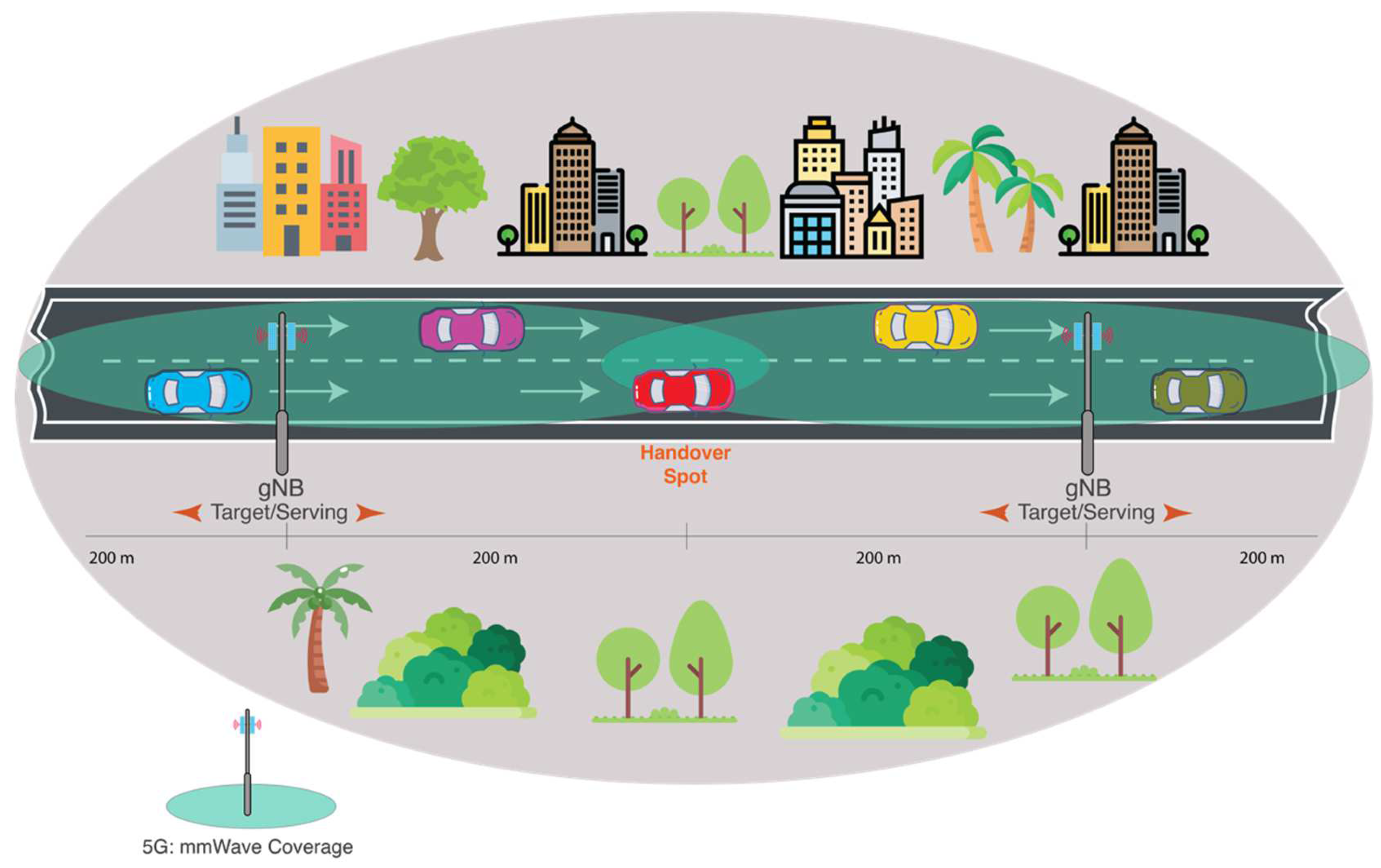

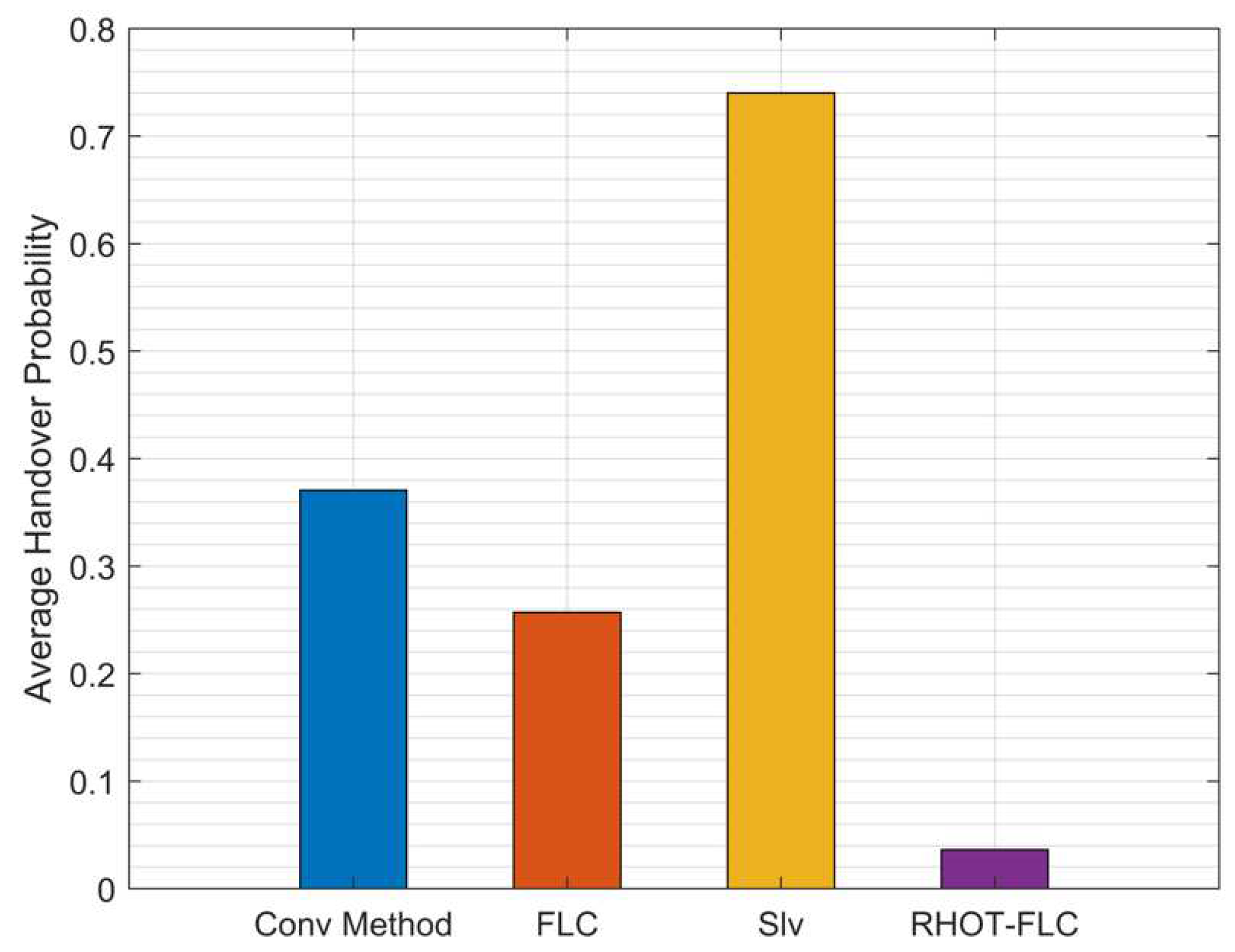


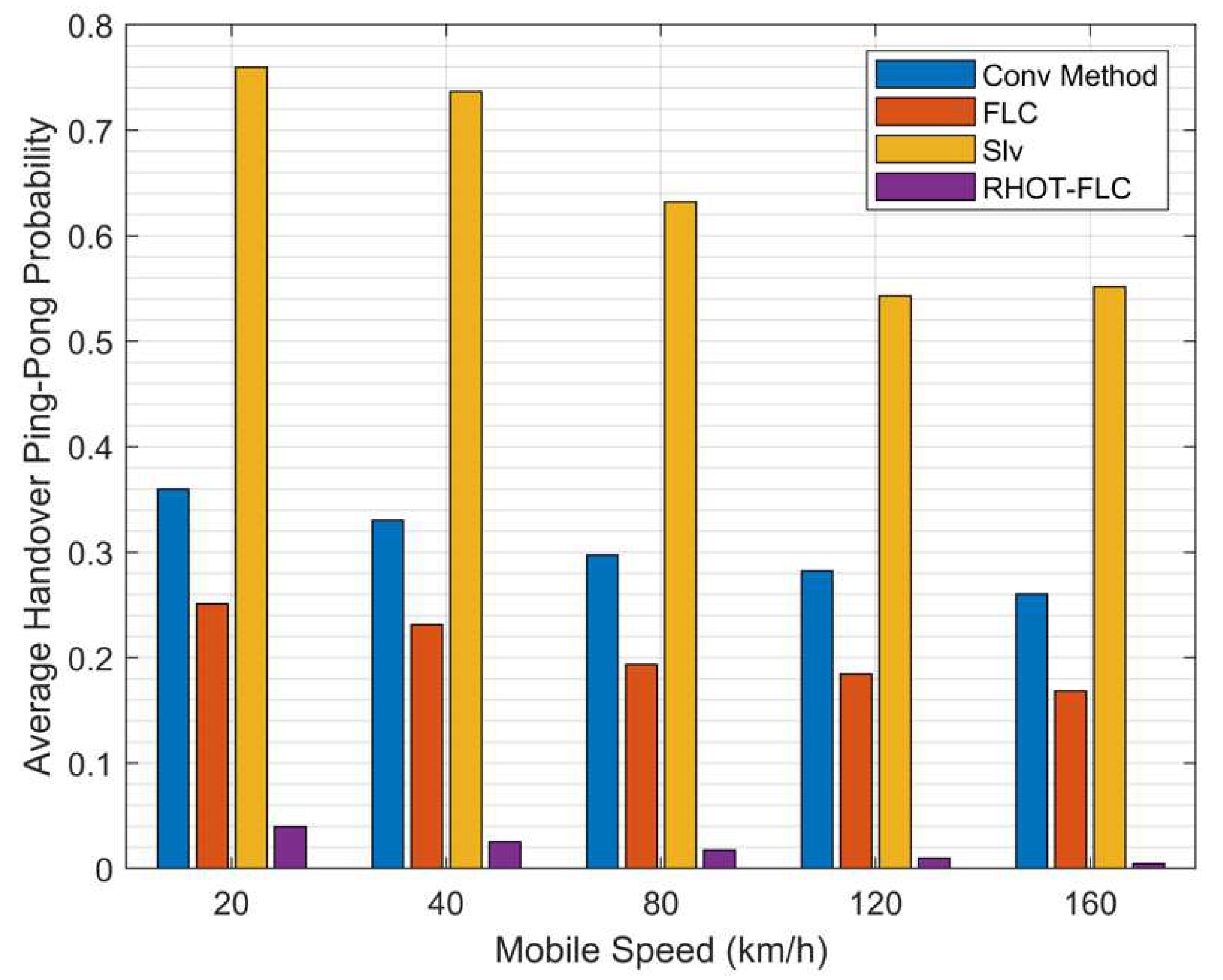
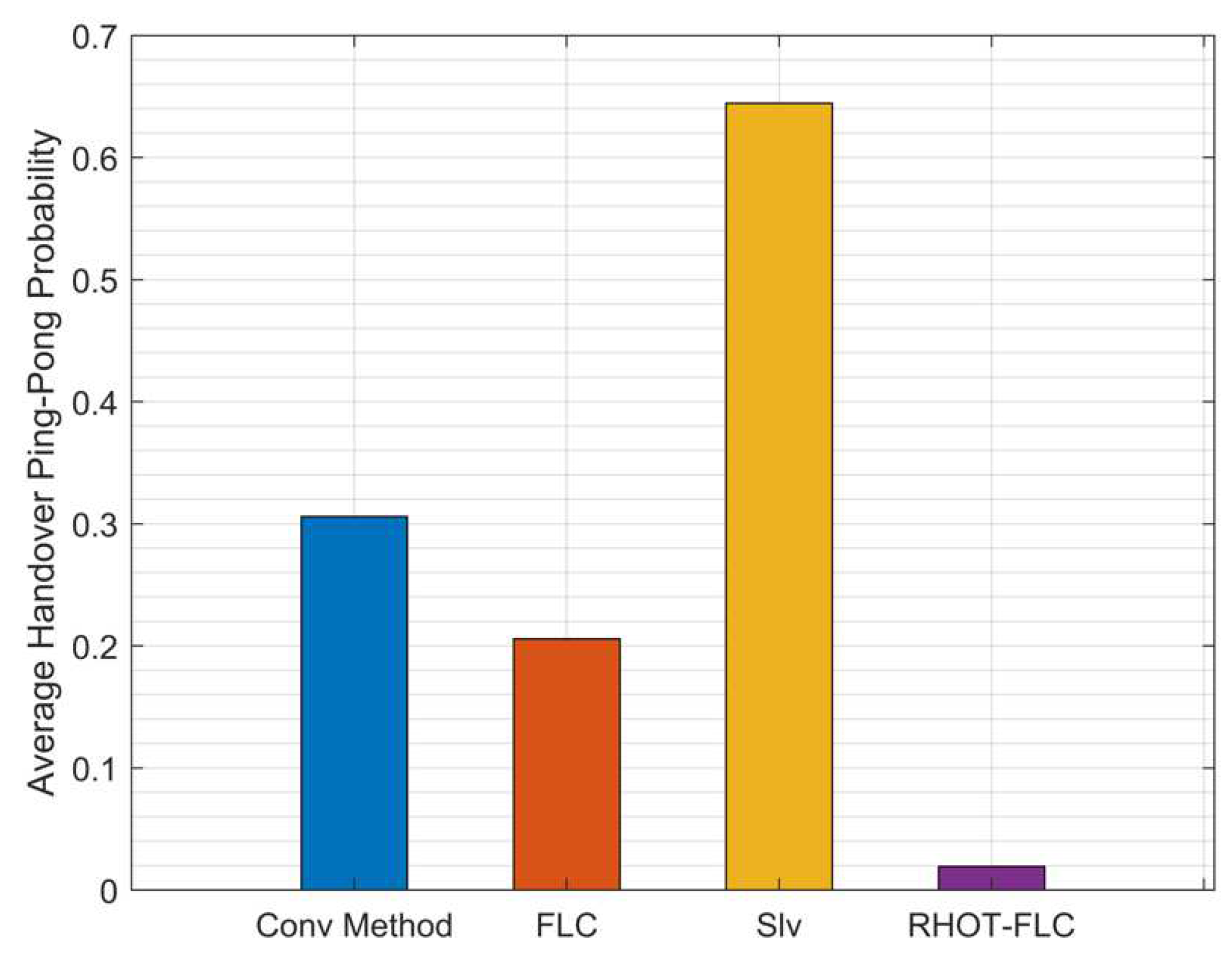

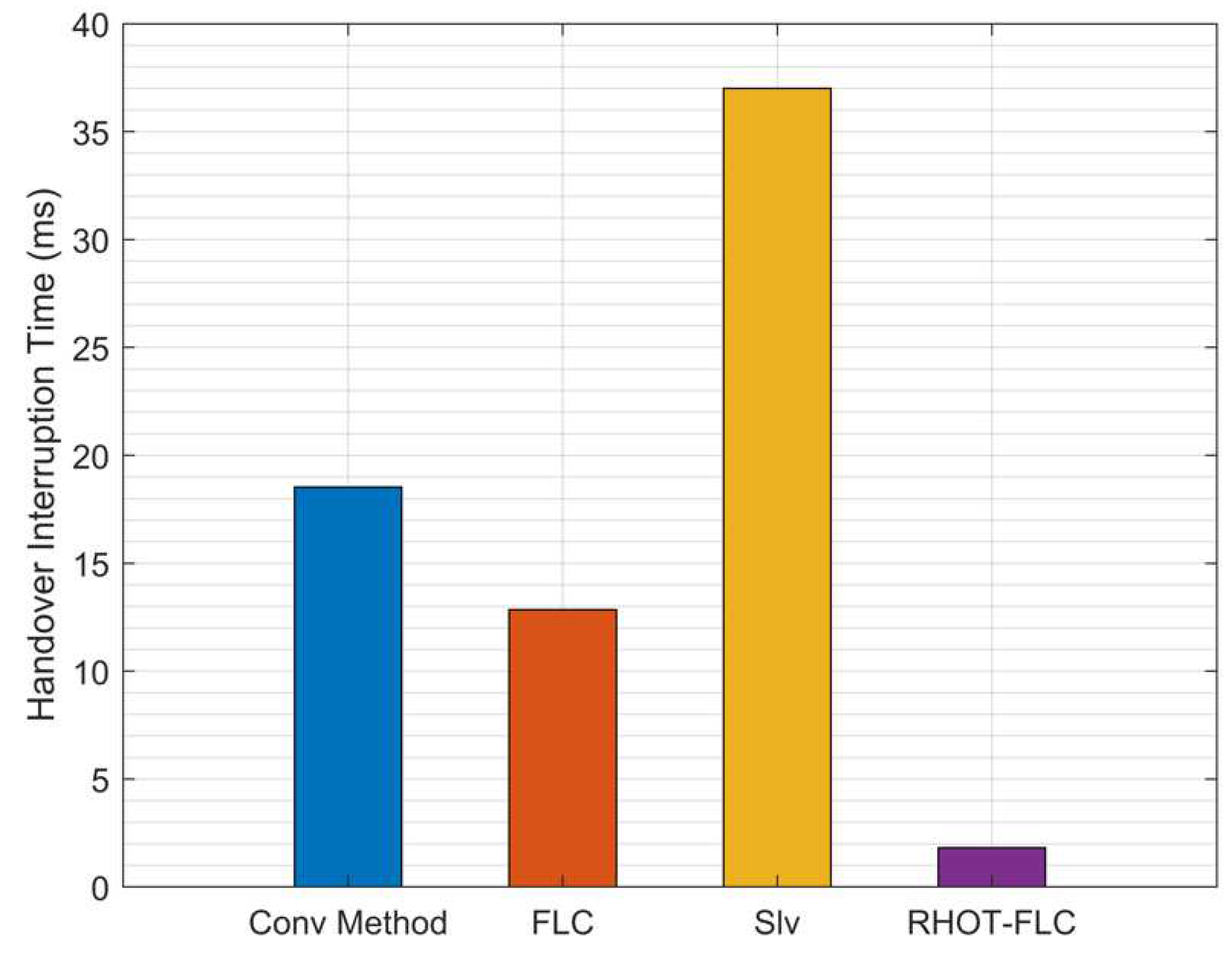
| Ref. | Problem | Solution | System | Optimization Parameters | Performance Metrics |
|---|---|---|---|---|---|
| [8] | Deterioration in the provided quality of services due to a high number of HOs because of failure to rank the priority of BS. | Self-optimization based on AHP-TOPSIS-Fuzzy to select the target cell | Small Cells/HetNets | HOM | HOPP and HOF |
| [14] | Providing automated operation for Self-Organizing Networks (SONs). | FLC-based technique that adaptively adjusts HOM | LTE | HOM | Call drop ratio and HO ratio |
| [15] | A high number of HOs in networks of a large number of small cells | Self-optimization algorithm based on FL exploiting users’ speed and radio channel quality to adjust HOM | Dense Small-Cell Networks | HOM | Number of HO, HOF ration, and HOPP |
| [16] | Occurring HOF as a result of RLF, which reduces the system’s performance | MRO algorithm to adjust TTT and offset according to HOF reason | 4G/Small Cells Networks | TTT | RLF and HOPP |
| [18] | RLF and HOPP for users using real-time traffic | MRO algorithm based on fuzzy Q-learning to adjust HOM | LTE | HOM | RLF and HOPP |
| [20] | Increased HOPP, number of HOs, unnecessary HOs, and frequent HOs due to deployment of a massive number of BSs | Self-optimization algorithm based on FL-TOPSIS Handover Decision-making Algorithm | 4G | HOM | Number of HO and HOPP |
| [21] | Increasing HOF affects the QoS of the system | Fuzzy AHP-based technique that correctly selects the optimal network among the available networks as a target network with HO | LTE/ HetNets | HOF | |
| [22] | Increasing the number of HOs increases the HOPP and HOF due to the deployment of a massive number of BSs | Self-optimization based on WFSO to adapt HOM and TTT | 4G/5G HetNets | HOM and TTT | RLF, HOPP, and HOF |
| [24] | Degradation in QoS due to a high probability of HOF and HOPP | Self-optimization based on PSO to adjust HOM and TTT | 4G | HOM and TTT | HOPP and HOF |
| Input | Degree | Range |
| Velocity | slow | 0 to 30 km/h |
| moderate | 25 to 70 km/h | |
| high | 65 to 135 km/h | |
| very high | 130 to 160 km/h | |
| RSRP | weak | −160 to −95 dBm |
| moderate | −100 to −73 dBm | |
| strong | −80 to −20 dBm | |
| RSRQ | poor | −60 to −18 dB |
| good | −22 to −12 dB | |
| very good | −14 to −6 dB | |
| excellent | −10 to +20 dB | |
| Output | Degree | Range |
| TTT | very short | 0 to 220 ms |
| short | 210 to 380 ms | |
| average | 370 to 520 ms | |
| large | 510 to 640 ms | |
| HOM | very low | 0 to 0.3 dB |
| low | 0.2 to 0.5 dB | |
| average | 0.4 to 0.8 dB | |
| high | 0.7 to 1 dB |
| Parameter | Values |
|---|---|
| Environment | Micro cells, urban area, B5G networks |
| Cell Layout | Hexagonal grid |
| Simulation Area (m) | |
| Number of gNB | 61 |
| Number of Sectors | 3 |
| Cell Radius (m) | 200 |
| Maximum Number of UE per Cell | 200/cell |
| Maximum Number of PRB per UE | 2500 |
| Number of Measured UE | 10 |
| Carrier Frequency (GHz) | 28 |
| System Bandwidth (MHz) | 500 |
| White Noise Power Density (dBm/Hz) | 174 |
| Path Loss | |
| Shadow Fading (dB) | |
| gNB Hight (m) | 10 |
| UE Hight ) (m) | 1.5 |
| UE Speeds (km/h) | (20, 40, 80, 120, 160) |
| UE Power (dBm) | 23 |
| Transmission Power (dBm) | 35 |
| Mobility Model | Straight-way within 8 possible directions [N, NE, E, SE, S, SW, W, and NW] |
| HO Decision | Equation (2) |
| TTT (ms) | Adaptive: |
| HOM (dB) | Adaptive: |
| KPI | Conv | FLC [14] | Slv [15] | RHOT-FLC |
|---|---|---|---|---|
| HOP (%) | 37 | 25.7 | 74 | 3.6 |
| HOF (%) | 2 | 1.4 | 4.6 | 0.19 |
| HOPP (%) | 30 | 20 | 64 | 1.9 |
| HOL (ms) | 35.9 | 25 | 70.8 | 3.7 |
| HIT (ms) | 18.5 | 12.8 | 37 | 1.8 |
| RHOT-FLC Overall improvement (%) | 90.76 | 86.78 | 95.5 |
Publisher’s Note: MDPI stays neutral with regard to jurisdictional claims in published maps and institutional affiliations. |
© 2022 by the authors. Licensee MDPI, Basel, Switzerland. This article is an open access article distributed under the terms and conditions of the Creative Commons Attribution (CC BY) license (https://creativecommons.org/licenses/by/4.0/).
Share and Cite
Alraih, S.; Nordin, R.; Abu-Samah, A.; Shayea, I.; Abdullah, N.F.; Alhammadi, A. Robust Handover Optimization Technique with Fuzzy Logic Controller for Beyond 5G Mobile Networks. Sensors 2022, 22, 6199. https://doi.org/10.3390/s22166199
Alraih S, Nordin R, Abu-Samah A, Shayea I, Abdullah NF, Alhammadi A. Robust Handover Optimization Technique with Fuzzy Logic Controller for Beyond 5G Mobile Networks. Sensors. 2022; 22(16):6199. https://doi.org/10.3390/s22166199
Chicago/Turabian StyleAlraih, Saddam, Rosdiadee Nordin, Asma Abu-Samah, Ibraheem Shayea, Nor Fadzilah Abdullah, and Abdulraqeb Alhammadi. 2022. "Robust Handover Optimization Technique with Fuzzy Logic Controller for Beyond 5G Mobile Networks" Sensors 22, no. 16: 6199. https://doi.org/10.3390/s22166199
APA StyleAlraih, S., Nordin, R., Abu-Samah, A., Shayea, I., Abdullah, N. F., & Alhammadi, A. (2022). Robust Handover Optimization Technique with Fuzzy Logic Controller for Beyond 5G Mobile Networks. Sensors, 22(16), 6199. https://doi.org/10.3390/s22166199











